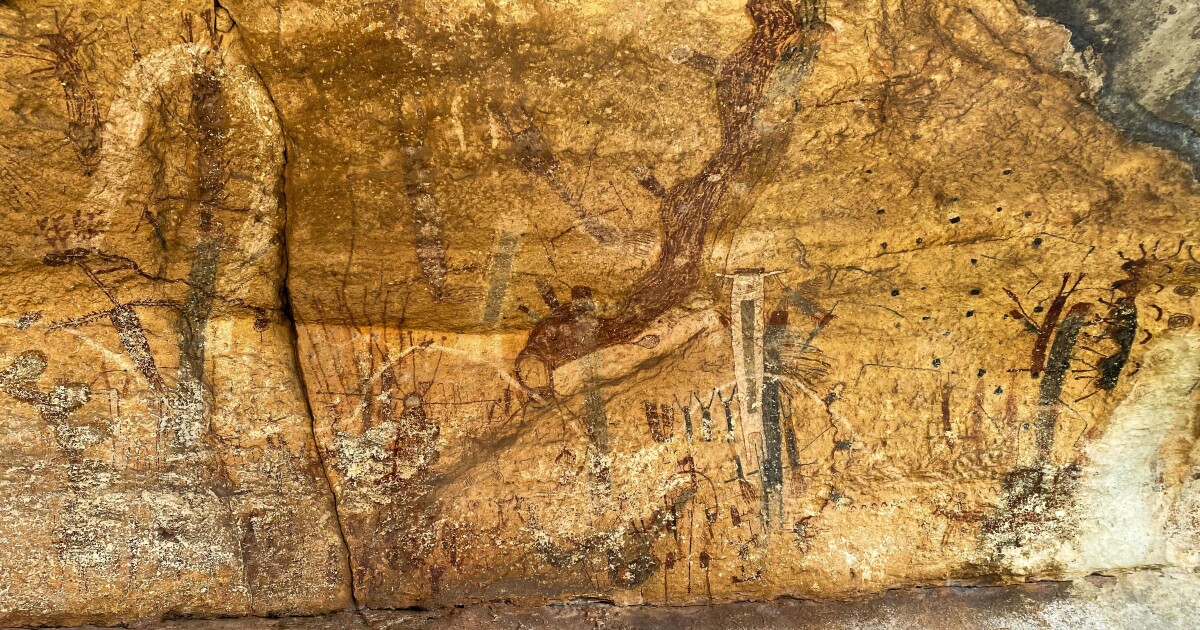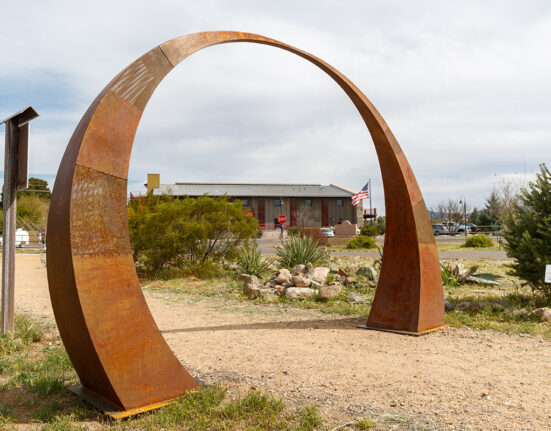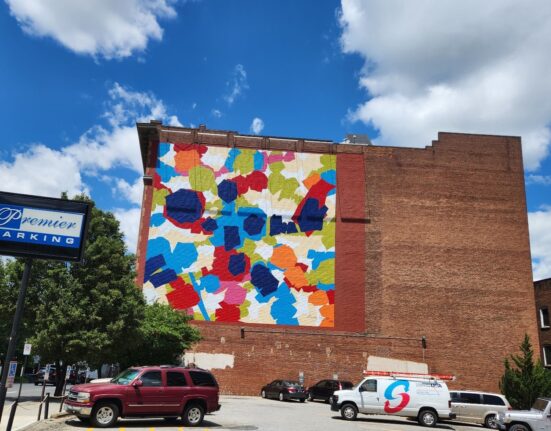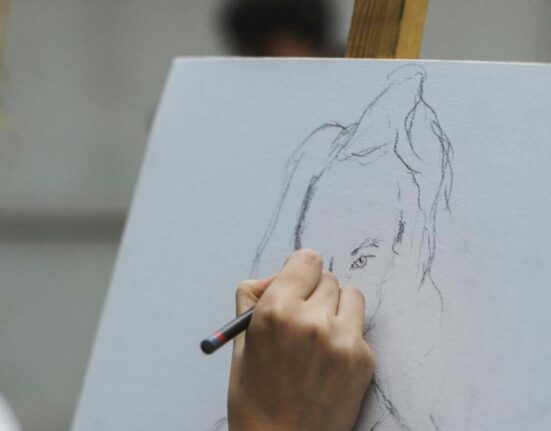There are few places that give you the ability to really have interchange with the ancients.
The Pecos Canyonlands northwest of Del Rio offers the chance to come face-to-face with mysterious artworks from ancient man.
First though, you’ve got to get there. Texas is, if nothing else, huge. The 200+ mile drive from San Antonio to the Seminole Canyon State Park is only about halfway to El Paso. The landscape approaching the Canyonlands north of Amistad Lake, is a deceptive mix. Rolling hills give way to flatlands, which then disappear into craggy canyons.

Those who come to Seminole Canyon State Park descend 250 feet from the interpretive center perched canyonside. Park Ranger Tanya Petruney and a tour of about 10 peopled entered into a limestone overhang shelter…and there they were.
“When you look at the upper-to-mid wall, those are the Lower Pecos River style pictographs,” Petruney said.
Painted pictures emerged from the limestone walls: rectangular humans with feet and legs, arms and, of all things, antlers. She said the paintings don’t automatically reveal their meanings.
“We haven’t found that Rosetta Stone or Pictionary that tells us what these drawings mean,” she said.
And that’s why we’re here. To see firsthand the pictographs at Seminole Canyon State Park and The White Shaman shelter. Scientists and the curious have been studying these for years. Greg Williams’ curiosity has had him spending decades studying them.
“This is rough, rugged country for rough, rugged people,” Williams said. “Everything out here will stick you, poke you, hurt you, kill you.”
He’s been stuck and poked in these canyons almost all his life.
“This country is a sacred place because of all the stories that it holds here. The spirits of the people, what they have to teach us is written on these canyon walls,” he said.
Williams notes that nature didn’t design the place for easy access. In fact, he said some folks don’t even like this area.
“People with really big egos don’t seem to care for this place too much because you’re very small out here,” Williams said.
The gap between those who lived here then, and those who live here now, he said, is deeper and wider than the hundreds of canyons that make up this area.
“Our world today is science and technology. Their world was the world of spirits,” Williams said. “They didn’t know what we know. We don’t know what they knew. And I don’t know that we’ll ever come together. But being here is the hope that we will.”
Aimee Spana is the Director of the White Shaman shelter.
“We know that the people of the Pecos lived out here for thousands of years. And they expressed themselves through these incredible, pictographs,” she said.

Spana said the Witte Museum first put on scientific expeditions to the White Shaman in the 1930s, beginning a relationship which culminated six years ago with ownership.
“Since 2017, the Witte Museum has been the proud conservation stewards of the White Shaman Preserve,” Spana said.
We drove the two further miles to the White Shaman shelter, located another 250-feet down a canyon overlooking the Pecos River. We stood just feet from the White Shaman, which is about 26 feet wide and half that high. A series of painted figures in black, red, white and yellow, some slowly losing the intensity of pigment. The shapes seem both extremely unusual, yet somehow familiar.
“Over here on the left hand side, we have something that’s called a crenelated arch,” she said. “But what we see coming out of this is this small anthropomorphic figure, and it’s got antlers here with black dots on the very tip of the antlers.”
Anthropomorphs are figures with both human and animal attributes.
“The White Shaman is an anthropomorphic figure. It’s got this sort of white, elongated body with black in the middle,” Spana said. “And while it looks from afar that it’s primarily white, there are these really beautiful, intricate red lines within the body, you’ll see on the left arm of the white shaman hanging from its elbow is what we refer to as an elbow adornment, which to me appears to look almost birdlike, and perhaps like a hummingbird.”
In the South Pecos, there are more than 300 known pictograph shelters like the one called White Shaman. And these are not the works of just one ancient artist.
“There’s a rock art site that was dated at being over 5000 years old, some more recent at 2000. So this Pecos River style endured for thousands of years,” she said.
Spana said scientists have been trying to crack the code for decades as to what exactly the ancient artists were trying to say.
“You see a lot of these core motifs or attributes at so many different sites, and that the radiocarbon dating testing that they were painted at different times,” Spana said. “So the fact that you see these similar motifs over and over again or in different ways–it’s not a coincidence.”
Harry Shafer’s a scholar and researcher who’s been traveling to and studying the Lower Pecos Canyonlands for a long time. He said questions about The White Shaman come far easier than answers.

Courtesy the Witte Museum
“Why are they doing this? What’s the purpose? What’s the storyline?” he asked. I’ve been professionally active in Texas archeology for over 60 years. Back in the days when I was at UT and then later on, when I was at A&M, I ran several projects in the lower Pecos. And so I have done a lot of research down there.”
Few people alive know more about the White Shaman and the other pictographs than does Shafer. He said those ancient artists had to have been tough.
“You wonder how people could possibly get a living out there,” he said. “But to the people of the Pecos who lived there for over 13,000 years, it became a veritable garden to them because they learned how to use the plants to the maximum and whatever protein resources they could get, they harvested.”
A pair of women loom large in the first documented depictions of what The White Shaman looked like in the 1930s.

“Virginia Carson, who went down with Ellen Quillen and her team from the Witte back in 1931, did some watercolor recordings of the rock art, the first one,” he said.
Quillen actually began what’s now the Witte Museum in her San Antonio science classroom. Shafer said the four rock art colors are available in nature locally.
“The rock art, basically four minerals, red hematite, lime yellow laminate, black manganese and white kaolin, or gypsum,” Shafer said. “But what are you going to use to stick it to the wall?”
If water had been used they would have long ago disappeared to time. They found a method to make the paints into oil paints.
“And so they came up with some kind fatty material, which was basically an oil paint, he said. “And essentially what you see it at Seminole Canyon, and White Shaman, these are all oil paints.”
And in this setting where mysteries thrive, yet another mystery: exactly how did they paint them?

“If you go to some of those sites, the only way they could have done those paintings was to build scaffolds. I mean, 17, 18ft up,” Shafer said.
The mysteries that persist here are many and varied. Greg Williams sums up his view on The White Shaman.
“I think the experience that I’ve had here is you’re able to sit in the quiet and look at yourself. And imagine what was here,” he said. “You look at the artifacts, the stone tools laying on the ground. That’s not what interests me. It’s the painting, what they’re trying to convey. And there’s a lot of people that say they know what it means. I’m not sure that they do, but that’s not the important part. It’s just supposing knowing who they were, knowing who we are, and trying to find a balance between the two. And I think, that’s life.”







